Trend Model signal summary
Trend Model signal: Neutral (downgrade)
Direction of last change: Negative
The actual historical (not back-tested) buy and sell signals of the Trend Model are shown in the chart below:
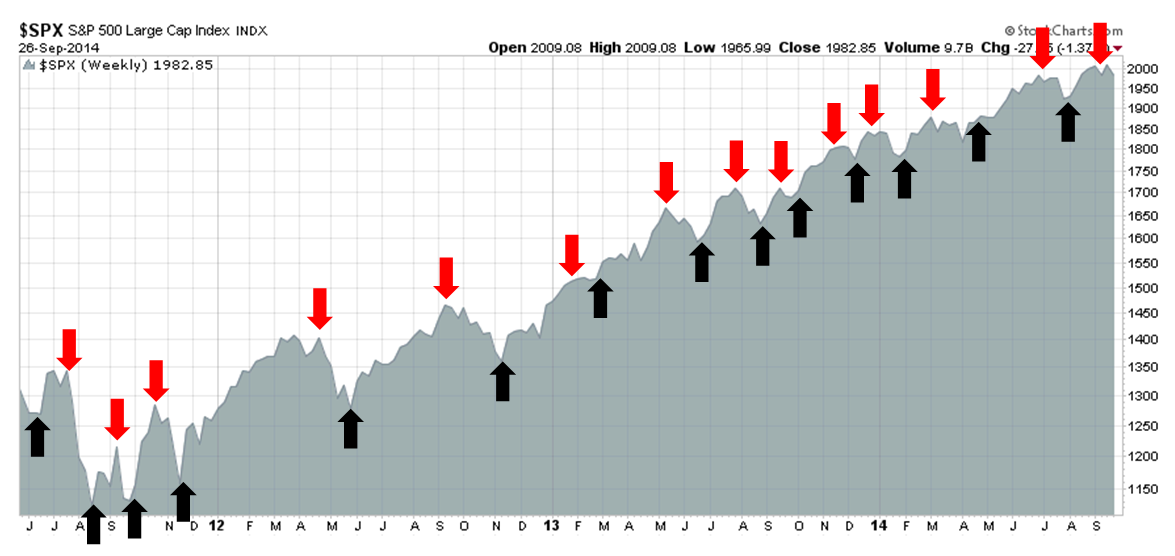
Another short shallow pullback, or...
Last week, I wrote about the downside risks to the US stock market and the macro backdrop remains unchanged (see 3 reasons to get more cautious on stocks):
- Valuations are elevated;
- Too much risk taking, with some of it on a leveraged basis; and
- Possible global growth scare
I would liken the first reason to someone deciding to ride a motorcycle without a helmet. It is risky behavior in the long-run, but it may mean nothing in the short-term as the motorcyclist may not get in an accident. The second would be analogous to the motorcyclist riding around at 100 mph without the helmet. It raises the risk level considerably and the consequences would be dire if there is an accident. The third is are potholes in the road, or the catalyst for the bears to come out of hibernation.
So far, while macro analysis suggests that the road is bumpy and the number of potholes are getting more numerous, the motorcyclist hasn`t wiped out. European growth continues to slow. China is slowing and Beijing shows no immediate desire for anything but small targeted stimulus programs. In the US, the growth outlook remains mixed.
On the other hand, the forward EPS outlook remains buoyant. Analysis from Ed Yardeni shows that normalized forward 12 month consensus EPS estimates are continuing to rise:

Several weeks ago, I rhetorically asked, "Is it time to sell Rosh Hashanah" and buy Yom Kippur, in accordance with the old Wall Street adage? At the time, the Trend Model remained bullish, but market internals were starting to deteriorate. The Trend Model did subsequently tactically turn bearish and remains bearish today (see A tactical sell signal, but no signs of a major top).
Buy Yom Kippur?
As Wall Street adages go, its past history has been pretty good (via Chad Gassaway).
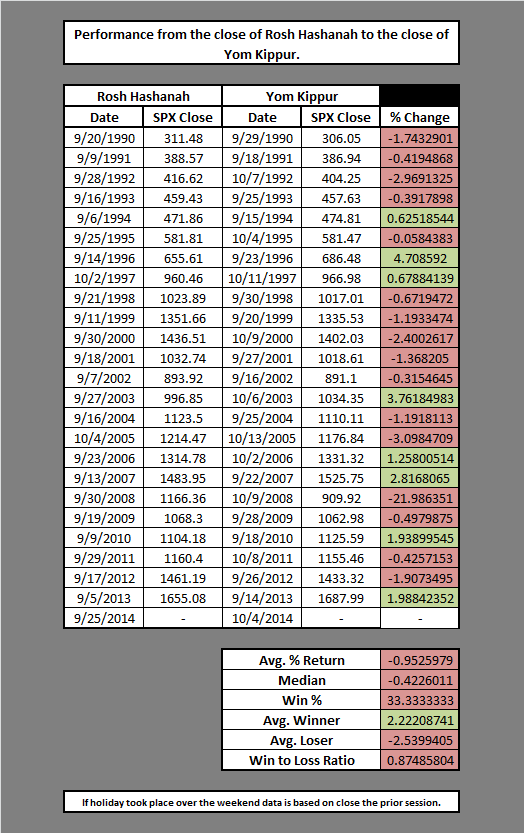
As we approach Yom Kippur (October 2-3), is it time to heed the adage, or is the market likely to fall even further?
Market oversold, but...
From a tactical viewpoint, oversold conditions are showing up in a number of market breadth based technical indicators, These include the NYSE 52-week New Highs-New Lows, the NYSE McClellan Oscillator and the Percentage of S&P 500 stocks above the 200 day moving average, all of which are shown in the chart below.

I have also marked (in blue vertical lines) previous instances where these indicators have all flashed oversold conditions at the same time that have have marked an interim market bottom. On the other hand, the red vertical lines show past instances when these three oversold conditions have not marked a sustainable low, when the market rallied briefly and went on to decline again. Note the % of stocks above the 200 DMA is unreliable as an oversold indicator as it is difficult to ascertain the level when it is deemed to be oversold.
In particular, this trifecta of oversold indicators was unsuccessful in calling the 2011 bottom as the NYSE HL was the only indicator that flashed an oversold condition, while the McClellan Oscillator was not oversold and % of stocks above the 200 DMA was unreliable as an oversold indicator.
Remember, oversold doesn`t mean that the market goes up. Oversold markets can get more oversold.
For a more reliable method of calling a tactical bottom, I turn to the indicators I used last time to successfully call the previous rally (see A tradable bottom?). The first is the combination of VIX term structure and NYSE TRIN. An inverted VIX term structure shows that option players are showing a high degree of fear and so does a TRIN reading greater than 2. As the chart below shows, while TRIN rose above 2 last week, the VIX-VXV ratio as a measure of VIX term structure is far from inversion (shaded zone). As well, the absolute value of the VIX Index is still below previous points that have marked previous interim lows, which are shown by the vertical blue dotted lines when VIX-VXV rose above 1 and TRIN was above 2. The charts in my previous post shows a longer history of the combination of these two indicators, which have had a 100% success in calling interim bottoms (see A tradable bottom?).
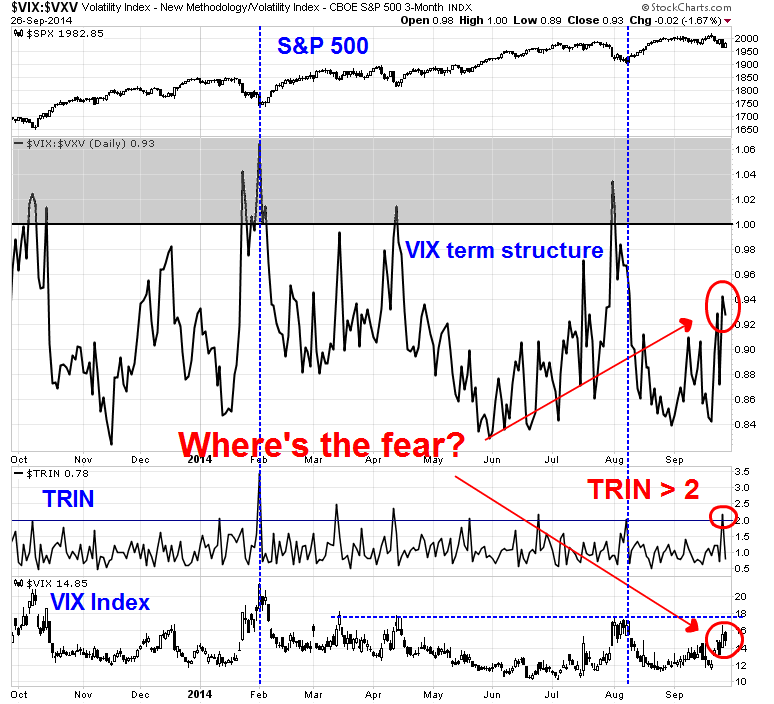
As well, my previous post highlighted my favorite overbought-oversold indicator, which has not reached an oversold condition as of last Friday:
Overbought-Oversold Indicator (in blue)
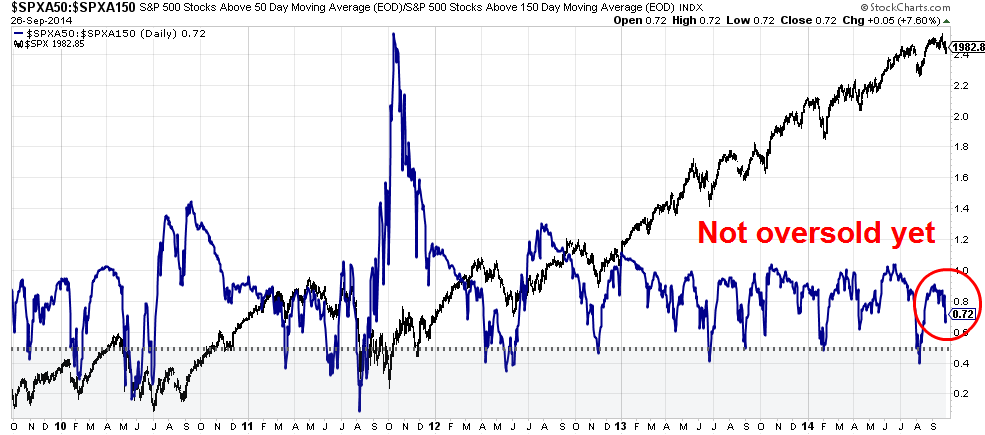
I interpret these conditions as the market getting oversold, but I would like to see further downside before declaring an interim bottom. Indeed, other sentiment indicators such as Rydex Funds Flows, which measure funds committed, instead of investor opinions, are nearing crowded short readings, but they are not quite there yet.
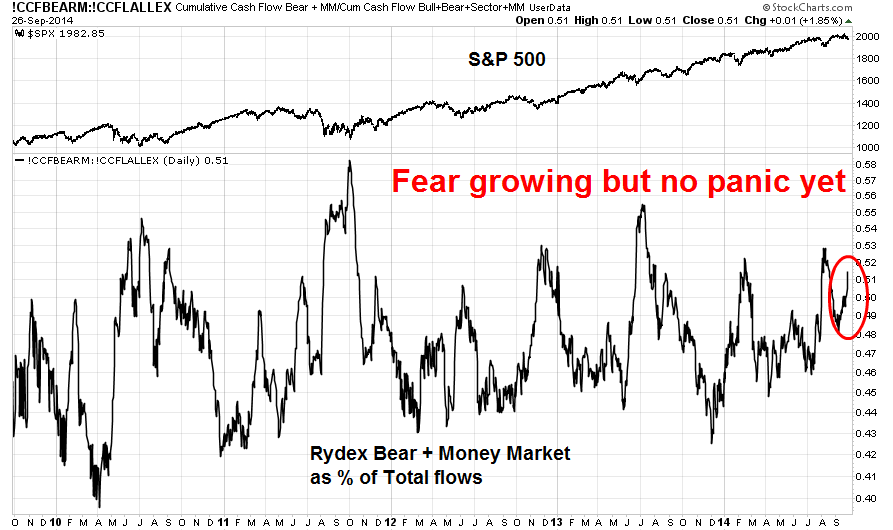
The psychological character of this stock market has shown itself where participants are jittery and panic easily. As a result, pullbacks have been extremely mild and less than 5% (whatever happened to the 10% correction?). If it were to sell off in the next few days, then the adage of buying on Yom Kippur might not be such a bad idea.
Conditions for a deeper decline
While a market bottom in the next few days which then continues, the slow grind up back to new all-time highs is my base case scenario, I do have an alternative scenario where the market bottoms, rallies and then falls further to a deeper decline. Here are the catalysts for a more serious correction that I am watching for:
What happens to earnings expectations? We are once again approaching Earnings Season. Ed Yardeni's analysis showed that Q3 EPS estimates are dropping fast, but he interpreted those conditions as lowering the bar so companies can more easily beat Street estimates.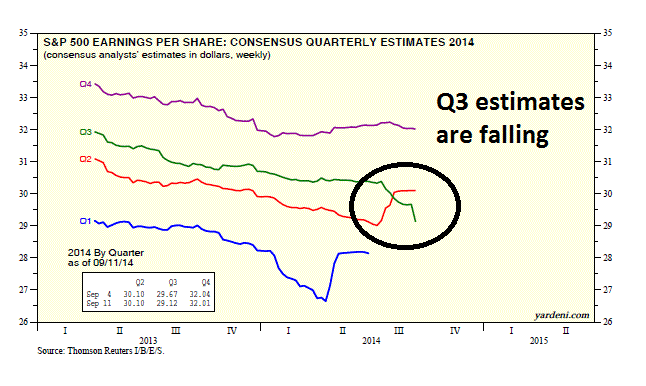
On the other hand, Urban Camel, writing at The Fat Pitch, pointed out that corporate buybacks are starting to wane and the last two episodes have coincided with falling stock prices. Share buybacks reduce the denominator in EPS and, without that tailwind, what will the effects be on EPS reports and earnings expectations?
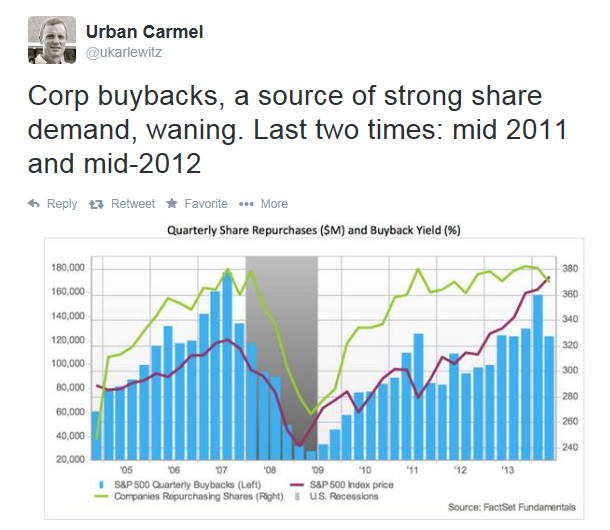
How will risk appetite evolve? We recently saw risk aversion rise as junk bond spreads started to blow out. Is this a temporary condition or could USD strength be pressuring EM bonds and currency markets?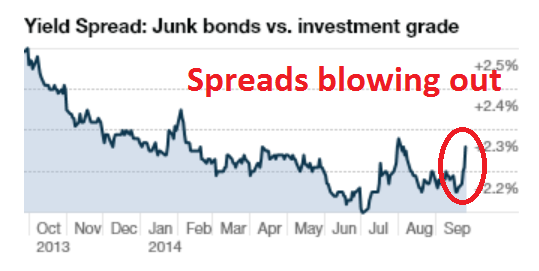
Despite the overbought and extended nature of the USD rally, Jason Goepfert reported that Dollar hedgers (the so-called "smart money") are piling into greenback strength.
To be sure, there are unconfirmed reports that the recent sell-off in junk bonds is temporary and related to positioning by PIMCO:
How will the geopolitical tensions develop? Winter is coming, will Russia and Ukraine reach an accommodation? How will the EU and NATO react? If global growth were to slow further and pressure oil prices downward, how badly will it hurt the Russian economy?
Over in Asia, how will Beijing react to the latest developments in Hong Kong's Occupy Central pro-democracy campaign? Could China institute a crackdown in a way that would spook the markets. (See my previous post Big trouble in little Hong Kong for the key quote: "The fact that you are allowed to stay alive, already shows the country's inclusiveness").
These are all good questions that I am watching. In the meantime, my inner trader remains short the market, with tight stops.
Disclosure: Long SPXU, SQQQ. I will be tweeting live updates during the week at @humblestudent as markets conditions evolve.
Cam Hui is a portfolio manager at Qwest Investment Fund Management Ltd. ("Qwest"). This article is prepared by Mr. Hui as an outside business activity. As such, Qwest does not review or approve materials presented herein. The opinions and any recommendations expressed in this blog are those of the author and do not reflect the opinions or recommendations of Qwest.
None of the information or opinions expressed in this blog constitutes a solicitation for the purchase or sale of any security or other instrument. Nothing in this article constitutes investment advice and any recommendations that may be contained herein have not been based upon a consideration of the investment objectives, financial situation or particular needs of any specific recipient. Any purchase or sale activity in any securities or other instrument should be based upon your own analysis and conclusions. Past performance is not indicative of future results. Either Qwest or Mr. Hui may hold or control long or short positions in the securities or instruments mentioned.
